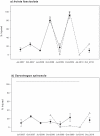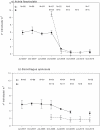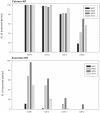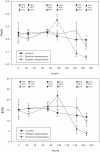Sponge mass mortalities in a warming Mediterranean Sea: are cyanobacteria-harboring species worse off?
- PMID: 21673798
- PMCID: PMC3105983
- DOI: 10.1371/journal.pone.0020211
Sponge mass mortalities in a warming Mediterranean Sea: are cyanobacteria-harboring species worse off?
Abstract
Mass mortality events are increasing dramatically in all coastal marine environments. Determining the underlying causes of mass mortality events has proven difficult in the past because of the lack of prior quantitative data on populations and environmental variables. Four-year surveys of two shallow-water sponge species, Ircinia fasciculata and Sarcotragus spinosulum, were carried out in the western Mediterranean Sea. These surveys provided evidence of two severe sponge die-offs (total mortality ranging from 80 to 95% of specimens) occurring in the summers of 2008 and 2009. These events primarily affected I. fasciculata, which hosts both phototrophic and heterotrophic microsymbionts, while they did not affect S. spinosulum, which harbors only heterotrophic bacteria. We observed a significant positive correlation between the percentage of injured I. fasciculata specimens and exposure time to elevated temperature conditions in all populations, suggesting a key role of temperature in triggering mortality events. A comparative ultrastructural study of injured and healthy I. fasciculata specimens showed that cyanobacteria disappeared from injured specimens, which suggests that cyanobacterial decay could be involved in I. fasciculata mortality. A laboratory experiment confirmed that the cyanobacteria harbored by I. fasciculata displayed a significant reduction in photosynthetic efficiency in the highest temperature treatment. The sponge disease reported here led to a severe decrease in the abundance of the surveyed populations. It represents one of the most dramatic mass mortality events to date in the Mediterranean Sea.
Conflict of interest statement
Figures









References
-
- Salomon S, Qin D, Manning M, Maquis M, Averys K, et al. Fourth's assessment report:The Physical Science Basis. Geneve: 2007. Intergovernmental Panel Climate Change. p. 114 p.
-
- Harvell CD, Kim K, Burkholder JM, Colwell RR, Epstein PR, et al. Emerging marine diseases —climate links and anthropogenic factors. Science. 1999;285:1505–1510. - PubMed
-
- Harvell CD, Mitchell JR, Ward S, Altizer A, Dobson RS, et al. Climate warming and disease risks for terrestrial and marine biota. Science. 2002;296:2158–2162. - PubMed
-
- Garrabou J, Coma R, Bally M, Bensoussan N, Chevaldonné P, et al. Mass mortality in Northwestern Mediterranean rocky benthic communities: effects of the 2003 heat wave. Glob Change Biol. 2009;15:1090–1103.
-
- Cerrano C, Bavestrello G, Bianchi N, Cattaneo-Vietti R, Bava S, et al. A catastrophic mass-mortality episode of gorgonians and other organisms in the Ligurian Sea (NW Mediterranean), summer 1999. Ecol Let. 2000;3:284–293.
Publication types
MeSH terms
LinkOut - more resources
Full Text Sources
Miscellaneous

